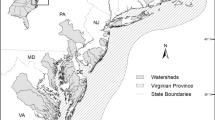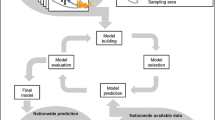Abstract
The distributions of freshwater mussels are controlled by landscape factors operating at multiple spatial scales. Changes in land use/land cover (LULC) have been implicated in severe population declines and range contractions of freshwater mussels across North America. Despite widespread recognition of multiscale influences few studies have addressed these issues when developing distribution models. Furthermore, most studies have disregarded the role of landscape pattern in regulating aquatic species distributions, focusing only on landscape composition. In this study, the distribution of Rabbitsfoot (Quadrula cylindrica) in the upper Green River system (Ohio River drainage) is modeled with environmental variables from multiple scales: subcatchment, riparian buffer, and reach buffer. Four types of landscape environment metrics are used, including: LULC pattern, LULC composition, soil composition, and geology composition. The study shows that LULC pattern metrics are very useful in modeling the distribution of Rabbitsfoot. Together with LULC compositional metrics, pattern metrics permit a more detailed analysis of functional linkages between aquatic species distributions and landscape structure. Moreover, the inclusion of multiple spatial scales is necessary to accurately model the hierarchical processes in stream systems. Geomorphic features play important roles in regulating species distributions at intermediate and large scales while LULC variables appear more influential at proximal scales.







Similar content being viewed by others
References
Allan JD (2004) Landscapes and riverscapes: the influence of land use on stream ecosystems. Annu Rev Ecol Syst 35:257–284
Allan JD, Castillo MM (2007) Stream ecology: structure and function of running waters, 2nd edn. Springer, Netherlands
Arbuckle KE, Downing JA (2002) Freshwater mussel abundance and species richness: GIS relationships with watershed land use and geology. Can J Fish Aquat Sci 59:310–316
Austin MP (2002) Spatial prediction of species distribution: an interface between ecological theory and statistical modeling. Ecol Modell 157:101–118
Box JB, Mossa J (1999) Sediment, land use, and freshwater mussels: prospects and probems. J North Am Benthol Soc 18:99–117
Byrd K, Kelly M (2006) Salt marsh vegetation response to edaphic and topographical changes from upland sedimentation in a Pacific estuary. Wetlands 26:813–829
Chinnayakanahalli K, Kroeber C, Hill R et al (2006) The multi-watershed delineation tool: GIS software in support of regional watershed analyses. Utah State University, Logan
Cummings KS, Mayer CA (1992) Field guide to freshwater mussels of the Midwest. Illinois natural history survey manual 5, Urbana
De’ath G (2007) Boosted trees for ecological modeling and prediction. Ecology 88:243–251
Elith J, Graham CH, Anderson RP et al (2006) Novel methods improve prediction of species’ distributions from occurrence data. Ecography 29:129–151
Elith J, Leathwick JR, Hastie T (2008) A working guide to boosted regression trees. J Anim Ecol 77:802–813
Environmental System Research Institute (2006) ArcGIS/ArcInfo for Windows XP Version 9.2.0. Redlands
Geology of Kentucky (2002) Kentucky geological survey, Lexington
Greene DC, Wolfe WJ (2000) Superfund GIS—1:250,000 Geology of Tennessee. United States Geological Survey, Nashville
Guisan A, Thuiller W (2005) Predicting species distribution: offering more than simple habitat models. Ecol Lett 8:993–1009
Johnson LB, Richards C, Host GE et al (1997) Landscape influences on water chemistry in midwestern stream ecosystems. Freshw Biol 37:193–208
Jones EBDIII, Helfman GS, Harper JO et al (1999) Effects of riparian forest removal on fish assemblages in southern Appalachian streams. Conserv Biol 13:1454–1465
Kearns FP, Kelly NM, Carter JL et al (2005) A method for the use of landscape metrics in freshwater research and management. Landscape Ecol 20:113–125
Leathwick JR, Rowe D, Richardson J et al (2005) Using multivariate adaptive regression splines to predict the distributions of New Zealand’s freshwater diadromous fish. Freshw Biol 50:2034–2052
Leathwick JR, Elith J, Francis MP, Hastie T, Taylor P (2006) Variation in demersal fish species richness in the oceans surrounding New Zealand: an analysis using boosted regression trees. Mar Ecol Prog Ser 321:267–281
Li H, Wu J (2004) Use and misuse of landscape indices. Landscape Ecol 19:389–399
Mackey BG, Lindenmayer DB (2001) Towards a hierarchical framework for modeling the spatial distribution of animals. J Biogeogr 28:1147–1166
McGarigal K, Marks BJ (1995) FRAGSTATS. Spatial analysis program for quantifying landscape structure. USDA Forest Service General Technical Report PNW-GTR-351
McRae SE, Allan JD, Burch JB (2004) Reach- and catchment-scale determinants of the distribution of freshwater mussels (Bivalvia: Unionidae) in south-eastern Michigan, U.S.A. Freshw Biol 49:127–142
Naiman RJ, Decamps H (1997) The ecology of interfaces: riparian zones. Annu Rev Ecol Syst 28:621–658
National Resources Conservation Service (2006) Digital general soil map of US. USDA, Fort Worth
Oakes RM, Gido KB, Falke JA et al (2005) Modelling of stream fishes in the Great Plains, USA. Ecol Freshw Fish 14:361–374
Olden JD, Jackson DA (2002) A comparison of statistical approaches for modeling fish species distributions. Freshw Biol 47:1976–1995
Opperman JJ, Lohse K, Brooks C, Kelly NM, Merenlender AM (2005) Influence of watershed-scale land use on salmonid spawning habitat in a Mediterranean-climate basin, California. Can J Fish Aquat Sci 62:2740–2751
Pearce JL, Boyce MS (2006) Modelling distribution and abundance with presence-only data. J Appl Ecol 43:405–412
Poole KE, Downing JA (2004) Relationship of declining mussel biodiversity to stream-reach and watershed characteristics in an agricultural landscape. J North Am Benthol Soc 23:114–125
Ricciardi A, Rasmussen JB (1999) Extinction rates of North American freshwater fauna. Conserv Biol 13:1220–1222
Ridgeway G (2006) Generalized boosted regression models. Available from ftp://ftp.auckland.ac.nz/pub/software/CRAN/doc/packages/gbm.pdf
Roy AH, Rosemond AD, Paul MJ et al (2003) Stream macroinvertebrate response to catchment ubranisation (Georgia, USA). Freshw Biol 48:329–346
Scott MC, Helfman GS, McTammany ME et al (2002) Multiscale influences on physical and chemical stream conditions across Blue Ridge landscape. J Am Water Resour Assoc 38:1379–1392
Standford JA, Ward JV (2001) Revisiting the serial discontinuity concept. Regul River 17:303–310
Strayer D (1983) The effects of surface geology and stream size on freshwater mussel (Bivalvia, Unionidae) distribution in southeastern Michigan. Freshw Biol 13:253–264
Townsend CR, Doledec S, Norris R et al (2003) The influence of scale and geography on relationships between stream community composition and landscape variables: description and prediction. Freshw Biol 48:768–785
Turner MG, Gardner RH, O’Neill RH (2001) Landscape ecology in theory and practice: pattern and process. Springer, New York
Vaughn CC (1997) Regional patterns of mussel species distributions in North American rivers. Ecography 20:107–115
Wang L, Lyons J, Kanehl P (2001) Impacts of urbanization on stream habitat and fish across multiple spatial scales. Environ Manage 28:255–266
Wang L, Lyons J, Rasmussen P et al (2003) Watershed, reach, and riparian influences on stream fish assemblages in the Northern Lakes and Forest Ecoregion, USA. Can J Fish Aquat Sci 60:491–505
Weigel BM, Wang L, Rasmussen PW et al (2003) Relative influence of variables at multiple spatial scales on stream macroinvertebrates in the Northern Lakes and Forest Ecoregion, USA. Freshw Biol 48:1440–1461
Weller DE, Jordan TE, Correll DL (1998) Heuristic models for material discharge from landscapes with riparian buffers. Ecol Appl 8:1156–1169
Williams JD, Warren ML, Cummings KS et al (1992) Conservation status of freshwater mussels of the United States and Canada. Fisheries 18:6–22
Wu J (2004) Effects of changing scale on landscape pattern analysis: scaling relations. Landscape Ecol 19:125–138
Acknowledgments
Much thanks goes to the Kentucky State Nature Preserves Commission, Kentucky Department of Fish and Wildlife Resources (KDFWR), Illinois Natural History Survey, Ohio State University, and the University of Michigan for providing sampling data sets. Funding for this project was providing by KDFWR. I would like to thank Mike Sears for introducing me to boosted regression trees. Special thanks go to L. J. Hopman, B. M. Burr, and R. F. Stapel for comments on early drafts. Much appreciation goes to the editor and two anonymous reviewers whose comments greatly improved the quality of the manuscript.
Author information
Authors and Affiliations
Corresponding author
Rights and permissions
About this article
Cite this article
Hopkins, R.L. Use of landscape pattern metrics and multiscale data in aquatic species distribution models: a case study of a freshwater mussel. Landscape Ecol 24, 943–955 (2009). https://doi.org/10.1007/s10980-009-9373-5
Received:
Accepted:
Published:
Issue Date:
DOI: https://doi.org/10.1007/s10980-009-9373-5




